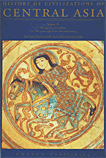|
 
Description of the
project Members of the International Scientific Committee List of contributors Introduction Chapter 1 Central Asia under the
Umayyads and the early cAbbasids Chapter 2 Sectarian and national
movements in Iran, Khurasan and Transoxania during Umayyad and early
Abbasid times Chapter 3 The states of the Oghuz,
the Kimek and the Kïpchak Chapter 4 The Samanid state Chapter 5 The Ghaznavids Chapter 6 The Karakhanids Chapter 7 The Seljuqs and the Khwarazm
Shahs Chapter 8 The Ghurids Chapter 9 The Uighurs, the Kyrgyz
and the Tangut (eighth to the thirteenth century) Chapter 10 The western Himalayan
states Chapter 11 The Kitan and the Kara
Khitay Chapter 12 The Mongols and their
state in the twelfth to the thirteenth century Chapter 13 Central Asia under the
rule of Chinggis Khan's
successors Chapter 14 The Delhi Sultanate Chapter 15 The regions of Sind,
Baluchistan, Multan and Kashmir: the historical, social and economic
setting Chapter 16 Central Asia under Timur:
from 1370 to the early fifteenth century Chapter 17 The Timurid states in
the fifteenth and sixteenth centuries Chapter 18 Popular movements, religious
trends and Sufi influence on the masses in the post-cAbbasid
period Chapter 19 Socio-economic development:
food and clothing in eastern Iran and Central Asia Chapter 20 Coinage and the monetary
system Conclusion Maps Bibliography and References Index Glossary of terms
|
![]()
